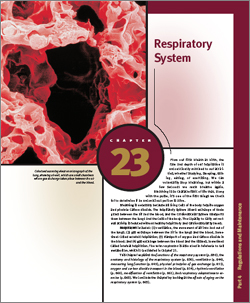
 | From our first breath at birth, the rate and depth of our respiration is unconsciously matched to our activities, whether studying, sleeping, talking, eating, or exercising. We can voluntarily stop breathing, but within a few seconds we must breathe again. Breathing is so characteristic of life that, along with the pulse, it's one of the first things we check for to determine if an unconscious person is alive. Breathing is necessary because all living cells of the body require oxygen and produce carbon dioxide. The respiratory system allows exchange of these gases between the air and the blood, and the cardiovascular system transports them between the lungs and the cells of the body. The capacity to carry out normal activity is reduced without healthy respiratory and cardiovascular systems. Respiration includes: (1) ventilation, the movement of air into and out of the lungs; (2) gas exchange between the air in the lungs and the blood, sometimes called external respiration; (3) transport of oxygen and carbon dioxide in the blood; and (4) gas exchange between the blood and the tissues, sometimes called internal respiration. The term respiration is also used in reference to cell metabolism, which is considered in chapter 25. This chapter explains the functions of the respiratory system (p. 830), the anatomy and histology of the respiratory system (p. 830), ventilation (p. 844), measuring lung function (p. 849), physical principles of gas exchange (p. 851), oxygen and carbon dioxide transport in the blood (p. 854), rhythmic ventilation (p. 860), modification of ventilation (p. 861), and respiratory adaptations to exercise (p. 865). We conclude the chapter by looking at the effects of aging on the respiratory system (p. 865). |